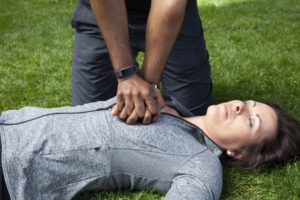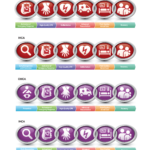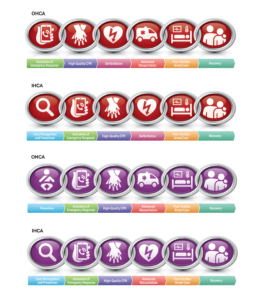
Uncategorized

Dad’s quick thinking and CPR save his son after near-drowning experience
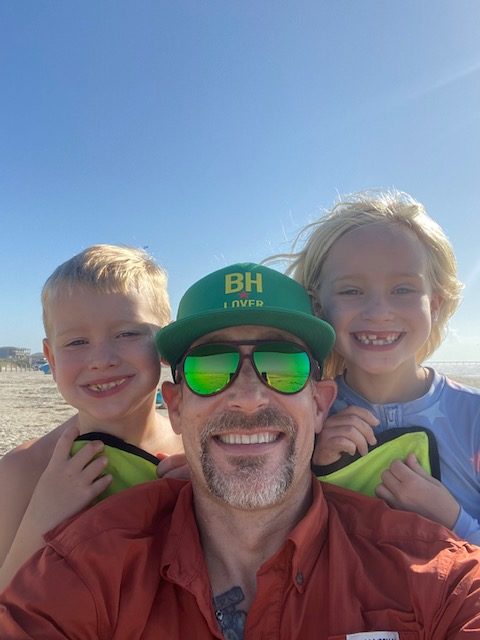
Pictured left to right: Max, Adam and Eleanor
By Gina Mayfield
In May 2019, just as San Antonio, Texas, started to heat up for the summer, Adam Biechlin decided to take his two kids for a swim while his girlfriend, Jennifer, finished making dinner. As he was heading out the door, he had a fleeting thought that barely registered in his mind: It’s always better not to be outnumbered by kids at the pool. And off they went.
That day, wind ripped around the 21-floor condominium tower where Jennifer lives, but Adam made it to the ground floor pool where he watched his 5-year-old daughter, Eleanor, do handstands in the water and played catch with his 3-year-old son, Max.
Eventually, Jennifer texted to say dinner was ready, and Adam called for both kids and watched them come running out of the water. He began collecting their belongings, which the wind had strewn across a small area, when Eleanor asked for just one more “Watch this, Dad!” moment.
Adam, who had turned his back for a few seconds knowing both kids had cleared the pool, turned back around. Then it hit him.
“I didn’t see Max,” he remembers. “I said, ‘Where’s your brother?’ Eleanor turned completely pale. My heart just sank. And then it started racing.”
Adam ran toward the pool and found Max floating face first in just 4 feet of water.
“It was an indescribable feeling,” Adam says.
He just remembers thinking, ”This is not happening. This can’t happen. This is not going to happen.”
Adam pulled Max from the pool. “He was like a sack of potatoes. His face was white, his eyes were closed, his lips were blue,” Adam says. “I just started screaming at the top of my lungs for someone to call 911.” But there wasn’t anybody around. “I had to do something,” he says.
Adam laid Max on the ground and began performing CPR. Turns out Adam’s cousin is married to longtime American Heart Association employee, Kelly Griesenbeck Carter, who had offered Adam and other relatives an Infant CPR class right before Eleanor was born. Everything he learned that day came rushing back to him.
After several attempts to revive Max, nothing seemed to help. So, Adam scooped him up and ran through a gate into a patio area where they found an elderly doctor they knew.
Once again Adam laid Max on the ground and began chest compressions, while the doctor stood watch.
“Keep going Dad, you’re doing alright,” the doctor said.
Then it happened. Max projectile vomited the Slurpee he had enjoyed earlier that day all over Adam.
“It was the most wonderful feeling,” Adam says with a smile of that first sign of recovery. Then, Max took a breath and started crying.
About that time, the paramedics arrived. (Residents as high as eight stories up had heard Adam’s frantic cries for help and called 911.) They checked Max’s vitals and rushed him off to the local children’s hospital.
It was there that Adam learned what had happened during the 10 seconds his back was turned. “I got blown in,” Max still explains to this day. Yes, that heavy wind had literally blown him right into the water as he was running.
Today, he’s a perfectly happy and healthy 5-year-old – and a strong swimmer. But about a month after the incident Adam learned how truly fortunate he was that he took that Infant CPR class all those years ago.

Pictured: Max
He ran into the doctor who had stood over him while he performed CPR at the pool that day. The doctor pulled Adam aside and said, “I just want to tell you, Dad, you did a great job because that boy was dead.”
In the year that has followed that fateful day, Adam has become an evangelist for CPR in his Alamo Heights community, warning other parents not to be lulled into a false sense of security at even a crowded community pool, often staffed by teenage lifeguards who are just kids themselves.
“Pay attention and stay hypervigilant near the water,” he says. “This happened in 10 seconds. Ten seconds. Things change in the blink of an eye.”
Nurse uses CPR to save passenger’s life on cruise
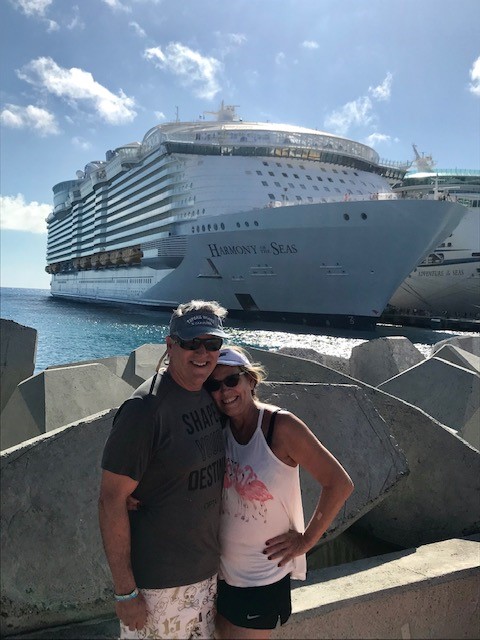
Pictured above: Mark and Diane Jones
By Gina Mayfield
Their week-long cruise had returned to port the night before, and with the ship safely docked in Fort Lauderdale, Florida, Mark and Diane Jones had slept in knowing that their disembarkation time was still hours away.
But just as the Joneses started to rouse, they heard a loud thump next door.
“Next thing I know, I hear a lady screaming at the top of her lungs in the hallway,” Diane recalls. “She was really, really screaming.”
Still in her nightgown, Diane ran out the door and found a small crowd gathered outside Andy and Michelle Katon’s room.
Inside, Andy had collapsed against the bathroom door. Mark, who had closely followed Diane, had to pull Andy away from the door and flip him over. That’s when Diane realized he was “extremely diaphoretic and cyanotic.” Those are the words an RN who spent a good part of her 38-year career in critical care uses to describe someone who is sweating profusely and turning blue.
“Get me an AED unit, call 911, get me some help here,” Diane said to the crowd while supporting Andy’s airway and constantly checking his pulse … until there wasn’t one.
She started Hands-Only CPR and waited for an AED unit. When it finally arrived, they shocked Andy once and his pulse returned to normal. He eventually started breathing on his own, and they transported him to a local hospital.
Then it was time for Diane and Mark to go downstairs – and have breakfast. When they met their friends, the conversation started with, “You guys aren’t going to believe what happened … .” What a morning it had been.
Turns out, Andy had a widow maker heart attack, which is almost always fatal without emergency care. “You’re only alive because of your next door neighbor’s actions,” the cardiologist told Andy.
Turns out this was the second time Diane used CPR to save a life outside of the hospital, the first time being at a college football game.
“I tell people, I don’t leave home without her,” Mark says with a laugh.
Since the rescue, the Joneses and Katons, who had never met before this incident, have gotten to know each other and planned on being together to mark the one-year anniversary of Andy’s survival in March 2020, then COVID-19 got in the way. Still, their bond is strong.
“It’s like we have a new family,” Mark says. “They’re very, very good people.”
“They call me their hero,” Diane says. “They always say they know Andy survived because of what I did. It was real rewarding to know that I saved his life. He was only 49 years old and had three children at home. They’ve all reached out to me to say, ‘Thank you for saving my dad.’ ”
Visit our Hands-Only CPR webpage to learn the two easy steps to save a life and check out Heartsaver® First Aid CPR AED for additional eLearning opportunities.
Youth baseball coach saves assistant coach’s life using CPR
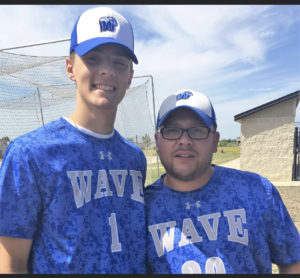
Left to right: David Dibble and Zach Sievers
By Gina Mayfield
In Spring 2017, youth baseball coach Zach Sievers got a call from former player David Dibble looking to land a spot on a local team. After having a hard time finding a place for the 19-year-old college freshman, Zach did the next best thing and offered him an assistant coaching position on his own 16 and under Wisconsin Wave team in Kenosha.
June rolled around, and David was in the bullpen going through the usual drills with the team.
“Then it happened,” Zach remembers. “David threw a pitch, the catcher threw it back to him. David looked at me, grabbed his chest and fell to his knees.”
Then came the face plant, which was so slow and controlled that Zach wasn’t sure what to make of it.
“I thought he might be playing a prank on somebody.” But David didn’t budge, even after Zach called out to him.
Zach ran over and realized this was no joke.
“David’s eyes were glazed over, his face was gray, his lips were purple,” Zach recalls. He directed another coach to call 911 and sprung into action.
“I checked David’s airways and didn’t feel any breath. I couldn’t see his chest rising. I checked for a pulse and couldn’t find one, so I started CPR.”
No one else at the ballpark that day knew CPR. Thankfully, Zach had been an electronics technician in the Navy, where he went through regular CPR and AED training.
While to Zach it felt like 15 seconds had passed between the time he started CPR and the time a fire truck arrived, it had actually been nine to 12 minutes.
“Where we were wasn’t the easiest place to get to, and we were between fire zones,” he says. One fireman took over CPR, while the other ran to get the portable AED.
“When I heard the AED announce it couldn’t detect a pulse, I knew for a fact at that point that David was in some trouble. At that point it became real.”
When Zach got to the hospital, paramedics told him they had to stop the ambulance twice to restart David’s heart. He still wasn’t stable.
“I was really just hoping he was going to make it,” Zach says.
Eventually the doctor came out and pulled him aside.
“He told me that if I hadn’t done what I did, David would have died. He wasn’t out of the woods yet, but his chances of living were much better. That was hard to hear. It could have gone either way.”
Flight for Life flew David to a major hospital in Milwaukee where it was discovered that he had atrial fibrillation (AFib).
“So, essentially his heart was just beating out of control, so much so that he didn’t have a pulse,” Zach says. “It was beating at such an interval that it was more like a flutter than a beat.”
David had a defibrillator inserted and spent a week in the hospital. While he was still there his Aunt Connie had an epiphany. She realized that what happened to David could happen to anyone. She went on to start the Dibbs17 CPR Challenge (a name created by combining David’s nickname and number) with the goal of training 1,700 people on CPR within one year.
Connie partnered with the American Heart Association and used its tools to train every last one of them, and that was just the beginning of the organization. They’ve also hosted AED Challenges, where participants take pictures of the AED in whatever building they’re in, just to see if they can find it.
“Connie has done more for David than I ever did,” Zach says humbly.
These days, Dibbs17 is still going strong, and so is David. He got cleared to play baseball again and is back on the field at the University of Wisconsin-Superior. But the Dibble family never forgot what Zach did for them.
“They call me their angel,” he says. “But it’s hard for me to hear ‘thank you’ because I just did what I was supposed to do.”
To hear more about Dibbs17 and David’s story, watch this video on YouTube.
Cardiac arrest survivor on a mission turns to music to raise awareness about CPR and AEDs
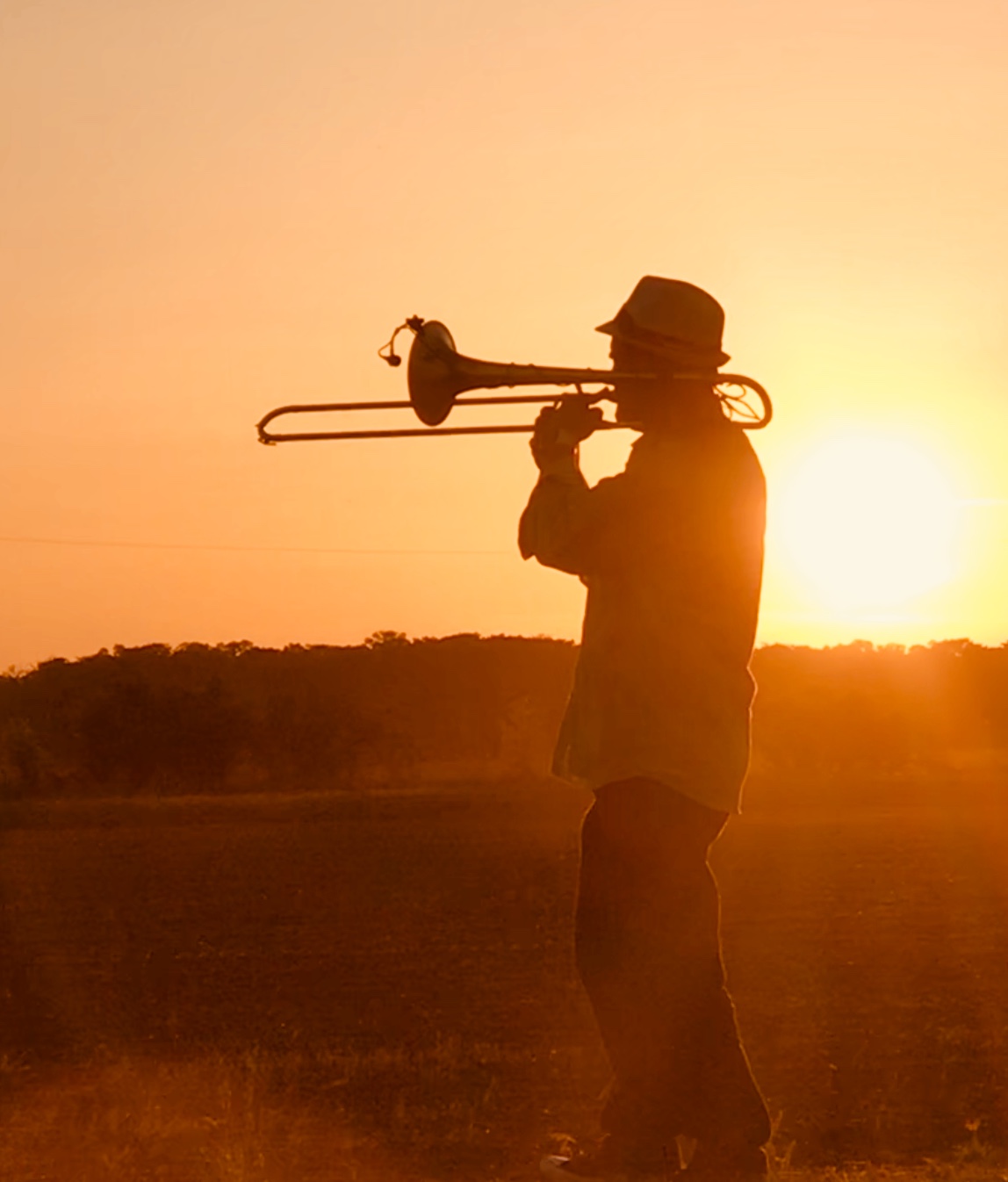
Pictured above: Maurice Trosclair
By Marissa Alanis
Each weekday at lunchtime, Maurice Trosclair ran four miles along the Lake Pontchartrain levee near his office building in Metairie, a New Orleans suburb. An avid runner, Maurice, 55, had completed a half-marathon nine days earlier.
But on Feb. 14, 2017, a gut feeling urged Maurice to end his run at the one-mile mark and to return to the office to finish some work. He also needed to pack before he left on a trip to New York City.
Maurice, a geosciences technician, also was a trombone player who was set to perform with Delfeayo Marsalis and the Uptown Jazz Orchestra the next day at Lincoln Jazz Center.
His cell phone buzzed as he walked toward the elevator in his office building. His wife, Nancy, had sent him a text to thank him for the Valentine’s Day card that he had taped to their backyard fence.
He was replying to Nancy’s text on the elevator ride to the ninth floor when he suddenly collapsed and fell facedown. Nancy’s text was the last thing Maurice would remember for the next four days. He had suffered a cardiac arrest.
Two women who were inside the elevator, Sandy Ortego and Kim Duplessis, immediately sprang into action when the elevator stopped.
Sandy dashed out to get help at Premiere Athletic Club located on the ninth floor where Maurice had been headed to take a shower. Kim stayed inside the elevator as it headed up to the 21st floor. The building has “smart” elevators where people select their floor destination before getting inside.
Kim grabbed Maurice’s phone before it locked up and called the last person he had texted. Nancy answered an incoming call on her cell phone at another gym where she was exercising.
“Hey baby,” Nancy said, fully expecting to hear Maurice’s voice. “Happy Valentine’s Day.”
There was an awkward silence.
“Do you know someone who works in this building?” Kim asked.
“Yes, of course, my husband,” Nancy said. “You called me from his phone.”
Kim tells Nancy that Maurice has just suffered a heart attack much to Nancy’s shock.
“What?” Nancy tells Kim. “He had just run a half marathon. He’s healthy.”
For the next 50 minutes, Kim keeps Nancy on the phone as the emergency response unfolded that would involve the assistance of six people, each playing a vital link in the chain of survival.
The elevator proceeded to the 21st floor next. When the doors opened, Suzanne Howard, a nurse for People’s Health, was nearby waiting for another elevator. She saw Maurice lying face down. She immediately ran over to him and started CPR while the elevator doors closed and proceeded to its next stop, which took about 10 minutes.
Meanwhile, Sandy arrived at the athletic club and told the manager, Roy Fontenelle, about Maurice’s situation. They called 911. Roy grabbed the health club’s Automated External Defibrillator (AED), which was the only AED in the building. Roy and club employee, Kaitlyn Reis, ran to go find Maurice.
The elevator finally arrived back on the first floor, where Tricha Arabie, another nurse who works for People’s Health, was waiting. Suzanne screamed that she needed help. Tricha took over the CPR efforts and tagged team with Suzanne.
Roy and Kaitlyn found Maurice on the first floor. The AED was deployed and shocked Maurice one time. Maurice was checked for a pulse before CPR resumed. When the EMT team arrived, they administered four additional shocks. They also put an automatic chest compression device known as a Lucas 3 and administered continuous manual breathing. The EMT team got Maurice on the ambulance and sped to East Jefferson General Hospital.
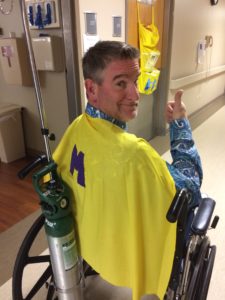
Maurice is discharged from the hospital.
Doctors intubated Maurice who was put in a medically induced coma. Four days later, he was released from the hospital donning a bright yellow cape with the letter “M” on the back.
Before he suffered a cardiac arrest, Maurice said AEDS were not top of mind for him.
“That’s the thing – the more we educated ourselves about what happened to me, it got to the point where at every place, I’m looking for an AED,” he said. “I’m performing at venues looking for the AED. It’s mind boggling how many places of high volumes of people traffic don’t have one.”
The lifesaving efforts that unfolded on Feb. 14, 2017 inspired Maurice and Nancy to form a nonprofit called Heartbeat NOLA, which encourages CPR training among residents, increases awareness about AEDs and raises funds to purchase AEDS for music venues throughout New Orleans.
Maurice, who also has written music for years, turned to music to help him cope with the anxiety and questions that lingered after his cardiac emergency. He said he also wanted to write to see if that part of his brain still functioned properly.
“The first song I wrote is ‘You Are Not Alone,’ because I had fellow survivors on my mind,” he said. “I was feeling what they’re feeling. The lyrics and music were meaningful to me but also the people I was writing for.”
He continued with his songwriting, which spurred his first solo album titled,” Grateful: A Sudden Cardiac Arrest Survivor’s Awakening,” which was released in December. All proceeds from album sales will benefit Heartbeat NOLA.
Twenty musicians collaborated on the project with Maurice, who said the album is a tribute to people who save lives and conveys the message that tomorrow is not guaranteed.
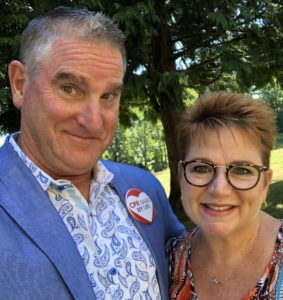
Maurice and Nancy
“When you put together all the songs that came together on this project, it’s a basically a musical thank you note to everyone that not only saved my life but save lives every day,” he said. “Because this whole experience has opened up my eyes that anybody can save someone’s life. If you have two hands, call 911 and get an AED.”
Maurice encourages the public to become educated about CPR during CPR and AED Awareness week, which is June 1-7. He said it’s important to learn CPR now more than ever as many people are spending a lot of time at home during the COVID-19 pandemic.
“Where do most cardiac arrests happen? In the home,” he said. “Chances are you’re going to save the life of somebody you love. Our EMS is stretched. We need to become citizen first responders. We need to play our role just like we are now with social distancing. We need to play our role in the first move in the chain of survival.”
